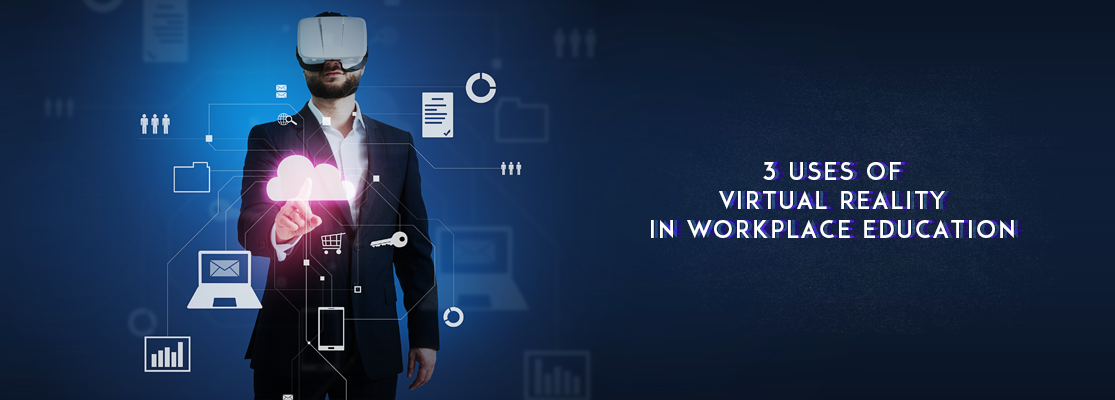3 USES OF VIRTUAL REALITY IN WORKPLACE EDUCATION
I’m always surprised when someone makes a sweeping declaration such as “No one’s using virtual reality in the workplace”. I heard this very statement recently at an e-learning conference. Yep, an e-learning conference.
Sure, VR is an emerging technology, but as 20 real-world examples of Virtual Reality can attest, early adopters are indeed putting it to use in the workplace.
I suspect the dismissiveness among some of our peers stems from their uncertainty about how they might apply it in their own contexts – particularly if that context is corporate.
However, I propose the opportunities for using virtual reality in the workplace – or more specifically, in workplace education – remain consistent across sectors according to the 3 use types that I outline below.
We corporate folks can learn from our peers in other sectors who are pursuing these uses, and translate their ideas in our own workplaces. All it takes is a bit of imagination.1. VIRTUAL REALITY CAN SUBSTITUTE THE REAL ENVIRONMENT
Virtual reality may be a feasible alternative when the real thing is infeasible – perhaps due to expense, logistics, or sheer impossibility.
Exemplars that spring to mind include: Google Expeditions which teleports you to wonderful places like Machu Picchu; VR Mars which let’s you walk on the surface of the red planet; and The Body VR which takes you for a ride through the human circulatory system.
I don’t know about you, but I don’t see myself visiting any of these places anytime soon. But I can visit a duplicated environment now, virtually. Of course I’m not really there, but it’s the next best thing.
This substitutive use of VR is being leveraged by a range of players in the workplace. For example, real estate agents offer virtual property tours; hotels show off their rooms; while architects visualise their designs (and modify them quickly and cheaply). The technology allows us – their customers – to experience each environment without having to physically go there.
Similar applications are more difficult to envisage in corporate L&D, so my advice is to return to the value proposition of the substitutive use of VR. Ask yourself: where would you like your colleagues to visit though it is currently infeasible to do so?
In my case, my employer is currently trialling new-look “concept stores” to transform the provision of financial advice. This strategic imperative relates to the overarching transformation of our organisation, so it’d be great if all our employees (and prospective customers!) could experience our flagship store in-person. But with people in different locations all over the world, that’s never going to happen. A 360° virtual tour is a feasible alternative.2. VIRTUAL REALITY CAN PREPARE YOU FOR THE REAL ENVIRONMENT
Virtual reality can be the first port of call when the real thing is high stakes – perhaps because it’s dangerous, emotionally charged, or financially sensitive.
Flight simulators are the obvious exemplar of this use of VR. These systems enable trainee pilots to test their skills and learn from failure in a replicated environment, without the fear of losing their life or causing millions of dollars worth of damage.
This preparatory use of VR is also being leveraged by a range of players in the workplace. For example, engineers preview the hazards of mining; electricians manipulate high-voltage switches; while someone I know in a rural fire service is looking into using 360° video to help volunteer firefighters get a sense of what to expect in a bushfire.
Again, similar applications are more difficult to envisage in corporate L&D, so my advice is to return to the value proposition of the preparatory use of VR. Ask yourself: what will your colleagues be doing that is high-stakes? Bearing in mind that in the corporate sense, “high stakes” is probably financial.
In my case, my employer is progressively remodelling our office building into an Activity Based Working environment. This represents a significant shift in how we go about our day-to-day business, so the project team has been running regular group tours to prepare each batch of employees who are scheduled to occupy the newly decked-out floors. I dare not calculate how many hours multiplied by the number of tour leaders and tour followers have been spent on this. A 360° virtual tour would have allowed everyone to learn the basics at their own pace at their own desk, without any loss of learning outcome.3. VIRTUAL REALITY CAN FOSTER EMPATHY
Finally, but no less importantly, virtual reality can foster empathy by putting you in another person’s shoes.
An exemplar that springs to mind is Fear of the Sky which uses 360° photos to immerse you in Syrian towns ravaged by barrel bombs.
This empathic use of VR is also being leveraged by players in the workplace. For example, doctors experience the hospital system as an emergency patient; while aged care workers see life through the eyes of someone with dementia.
The need for empathy is not restricted to charity and healthcare. Consider a retail environment in which your sales people can interact with a virtual customer, then have them replay that experience through the eyes of the customer. I also see an opportunity with VR for police officers to experience what it’s like to be hassled on the street, and conversely, for the public to appreciate what it’s like to be a police officer.
Returning to the corporate sector, ask yourself: where are the social interactions? In my workplace, the retail sales example that I suggested could be similarly applied to financial advisers, while our claims assessors would benefit from experiencing our company in the shoes of a grieving claimant. Then there are meetings, presentations, performance appraisals, and myriad other scenarios to simulate.In summary, sweeping statements such as “No one’s using virtual reality in the workplace” are nonsensical. Plenty of people are using the technology in their workplaces, and they are doing so according to 3 use types.
The substitutive use of VR allows us to experience an environment without having to go to there; the preparatory use of VR allows us to experience an environment before we go there; while the empathic use of VR allows us to experience our own environment as someone else.
I encourage you to consider how you might explore each of these use types in your own workplace.
In the meantime, those who say it cannot be done should get out of the way of those doing it.
Written by our Guest Blogger, Ryan Tracey
Ryan Tracey is the E-Learning Manager at a well-known financial services organisation in Australia. He is a former Editorial Board Member for eLearn Magazine, and is currently a council member for the Australian Institute of Training & Development.
Ryan has worked in corporate e-learning for over a decade, following several years in the higher education market. He holds a Master’s degree in Learning Sciences and Technology from the University of Sydney, is a regular contributor to industry magazines, and has won a bunch of training awards.
_________________________________
Copyright of posts written by our Guest Bloggers are their own.
Published on 05-Sep-2016






